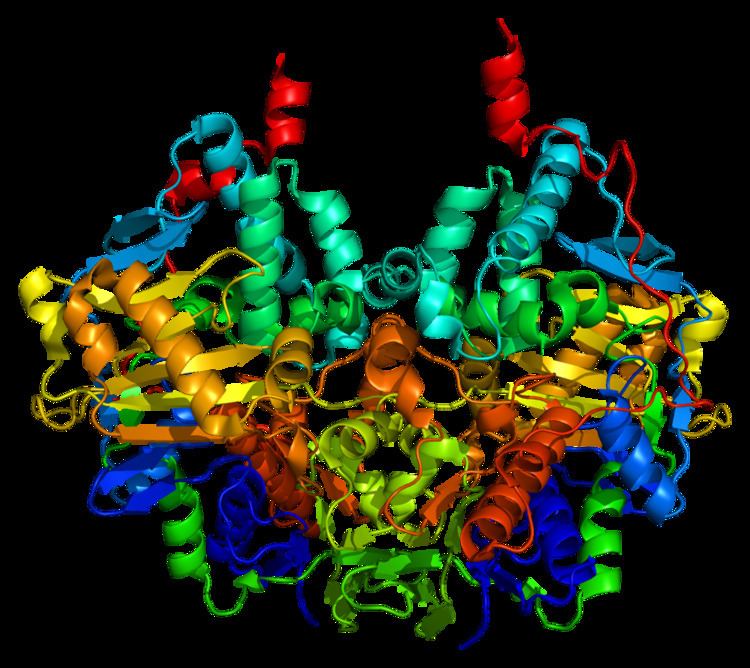Entrez 4129 | Ensembl ENSG00000069535 | |
 | ||
Aliases MAOB, Monoamine oxidase B External IDs MGI: 96916 HomoloGene: 20251 GeneCards: MAOB | ||
Monoamine oxidase B, also known as MAOB, is an enzyme that in humans is encoded by the MAOB gene.
Contents
- Structure
- Differences between MAOA and MAOB
- Roles in disease and aging
- Animal models
- Effects of deficiency in humans
- Selective inhibitors
- Natural
- Synthetic
- Irreversible covalent
- References
The protein encoded by this gene belongs to the flavin monoamine oxidase family. It is an enzyme located in the outer mitochondrial membrane. It catalyzes the oxidative deamination of biogenic and xenobiotic amines and plays an important role in the catabolism of neuroactive and vasoactive amines in the central nervous system and peripheral tissues. This protein preferentially degrades benzylamine and phenylethylamine. Like MAOA, it also degrades dopamine.
Structure
Monoamine oxidase B has a hydrophobic bipartite elongated cavity that (for the "open" conformation) occupies a combined volume close to 700 Å3. hMAO-A has a single cavity that exhibits a rounder shape and is larger in volume than the "substrate cavity" of hMAO-B.
The first cavity of hMAO-B has been termed the entrance cavity (290 Å3), the second substrate cavity or active site cavity (~390 Å3) – between both an isoleucine199 side-chain serves as a gate. Depending on the substrate or bound inhibitor, it can exist in either an open or a closed form, which has been shown to be important in defining the inhibitor specificity of hMAO B. At the end of the substrate cavity is the FAD coenzyme with sites for favorable amine binding about the flavin involving two nearly parallel tyrosyl (398 and 435) residues that form what has been termed an aromatic cage.
Differences between MAOA and MAOB
MAO-A is involved in the metabolism of tyramine; inhibition, in particular irreversible inhibition of MAO-A can result in a dangerous pressor effect when foods high in tyramine are consumed such as cheeses. MAO-A is involved in the metabolism of serotonin, noradrenaline and dopamine whereas MAO-B metabolises the dopamine neurotransmitter. MAO-B is an enzyme on the outer mitochondrial membrane and catalyzes the oxidation of arylalkylamine neurotransmitters
Monoamine oxidase A (MAOA) generally metabolizes tyramine, norepinephrine (NE), serotonin (5-HT), and dopamine (DA) (and other less clinically relevant chemicals). In contrast, Monoamine oxidase B (MAOB) mainly metabolizes dopamine (DA) (and other less clinically relevant chemicals). The differences between the substrate selectivity of the two enzymes are utilized clinically when treating specific disorders: Monoamine oxidase A inhibitors have been typically used in the treatment of depression, and monoamine oxidase B inhibitors are typically used in the treatment of Parkinson's disease. Nonspecific (i.e. MAOA/B combined) inhibitors can pose problems when taken concomitantly with tyramine-containing foods such as cheese, because the drug's inhibition of MAOA causes a dangerous elevation of serum tyramine levels, which can lead to hypertensive symptoms. Selective MAOB inhibitors bypass this problem by preferentially inhibiting MAOB, which mostly metabolizes DA. If MAOB is inhibited, then more DA is available for proper neuronal function, especially in Parkinson's Disease.
Roles in disease and aging
Alzheimer's disease and Parkinson's disease are both associated with elevated levels of MAO-B in the brain. The normal activity of MAO-B creates reactive oxygen species, which directly damage cells. MAO-B levels have been found to increase with age, suggesting a role in natural age related cognitive decline and the increased likelihood of developing neurological diseases later in life. More active polymorphisms of the MAOB gene have been linked to negative emotionality, and suspected as an underlying factor in depression. Activity of MAO-B has also been shown to play a role in stress-induced cardiac damage.
Animal models
Transgenic mice that are unable to produce MAO-B are shown to be resistant to a mouse model of Parkinson's disease. They also demonstrate increased responsiveness to stress (as with MAO-A knockout mice) and increased β-PEA. In addition, they exhibit behavioral disinhibition and reduced anxiety-like behaviors.
Inhibition of MAO-B in rats has been shown to prevent many age-related biological changes such as optic nerve degeneration, and extend average lifespan by up to 39%.
Effects of deficiency in humans
While people lacking the gene for MAO-A display mental retardation and behavioral abnormalities, people lacking the gene for MAO-B display no abnormalities except elevated phenethylamine levels in urine, raising the question of whether MAO-B is actually a necessary enzyme. Newer research indicates the importance of phenethylamine and other trace amines, which are now known to regulate catecholamine and serotonin neurotransmission through the same receptor as amphetamine, TAAR1.
The prophylactic use of MAO-B inhibitors to slow natural human aging in otherwise healthy individuals has been proposed, but remains a highly controversial topic.
Selective inhibitors
Species-dependent divergences may hamper the extrapolation of inhibitor potencies.
